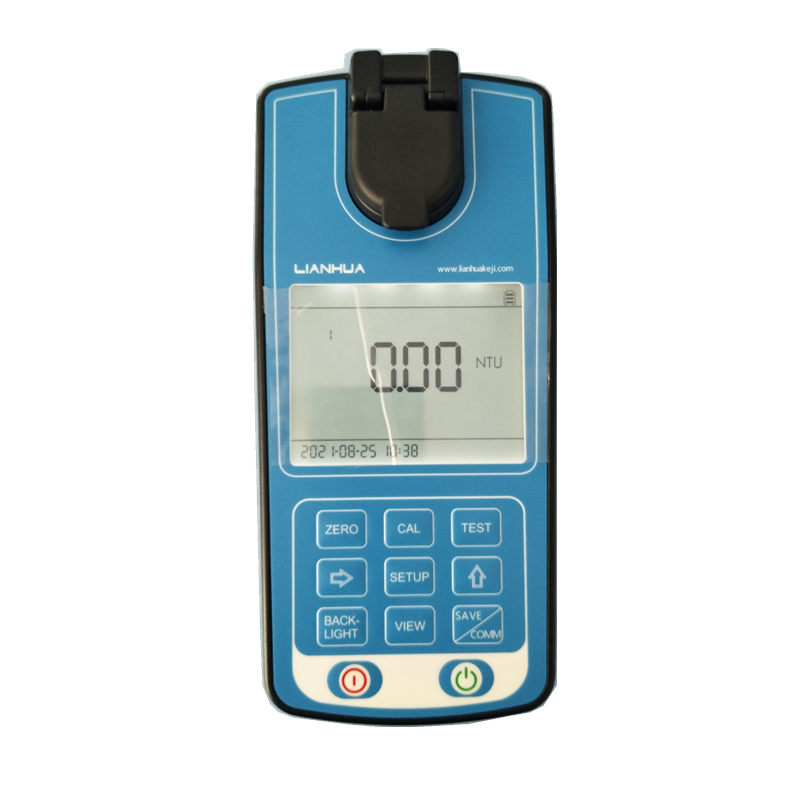Turbidity refers to the degree of obstruction of the solution to the passage of light, which includes the scattering of light by suspended matter and the absorption of light by solute molecules. The turbidity of water is not only related to the content of suspended substances in the water, but also related to their size, shape and refractive index. The unit is NTU.
Turbidity is usually suitable for water quality determination of natural water, drinking water and some industrial water. Suspended solids and colloids such as soil, silt, fine organic matter, inorganic matter, and plankton in water can make the water turbid and present a certain turbidity. According to the water quality analysis, the turbidity formed by 1 mg SiO2 in 1L water is one Standard turbidity unit, referred to as 1 degree. Generally, the higher the turbidity, the cloudier the solution. Turbidity control is an important part of industrial water treatment and an important water quality indicator. According to different uses of water, there are different requirements for turbidity. The turbidity of drinking water should not exceed 1NTU; the turbidity of supplementary water for circulating cooling water treatment is required to be 2 to 5 degrees; the influent water (raw water) for desalinated water treatment is turbid The degree of turbidity should be less than 3 degrees; the manufacture of man-made fibers requires that the turbidity of water should be less than 0.3 degrees. Since the suspended and colloidal particles that constitute turbidity are generally stable and mostly negatively charged, they will not settle without chemical treatment. In industrial water treatment, the methods of coagulation, clarification and filtration are mainly used to reduce the turbidity of water.
Turbidity measurement
Turbidity can also be measured with a nephelometer. A nephelometer sends light through a section of sample and measures how much light is scattered by particles in the water at a 90° angle to the incident light. This scattered light measurement method is called scattering method. Any true turbidity must be measured this way. The turbidity meter is suitable for both field and laboratory measurements, as well as continuous monitoring around the clock.
There are three methods for detecting turbidity: Formazin Nephelometric Units (FNU) in ISO 7027, Nephelometric Turbidity Units (NTU) in USEPA Method 180.1 and Nephelometry in HJ1075-2019. ISO 7027 and FNU are most widely used in Europe, while NTU is most widely used in the United States and other countries. ISO 7027 provides methods for the determination of turbidity in water quality. It is used to determine the concentration of suspended particles in a water sample by measuring the incident light scattered at right angles from the sample. The scattered light is captured by a photodiode, which generates an electrical signal, which is then converted to turbidity. HJ1075-2019 combines the methods of ISO7029 and 180.1, and adopts a dual-beam detection system. Compared with a single-beam detection system, the dual-beam system improves the accuracy of high and low turbidity. It is recommended in the standard to select a turbidimeter with an incident light of 400-600 nm for samples below 10 NTU, and a turbidimeter with an incident light of 860 nm±30 nm for colored samples. For this, Lianhua designed LH-NTU2M (V11). The modified instrument adopts a 90° scattering turbidimeter with automatic switching of white light and infrared double beams. When detecting samples below 10NTU, a 400-600 nm light source is used. When detecting turbidity above 10NTU Using 860nm light source, automatic identification, automatic wavelength switching, more intelligent and accurate.
1. EPA180.1 is issued by the US Environmental Protection Agency. It uses a tungsten lamp as the light source and is suitable for measuring low-turbidity samples such as tap water and drinking water. It is not suitable for colored sample solutions. Use 400-600nm wavelength.
2. ISO7027 is a standard issued by the International Organization for Standardization. The difference from EPA180.1 is that nano-LEDs are used as the light source, and multiple photodetectors can be used to avoid measurement errors caused by water sample chromaticity interference or stray light. Wavelength 860±30nm.
3. HJ 1075-2019 is issued by the Ministry of Ecology and Environment of my country, which combines the ISO7027 standard and the EPA 180.1 standard. With 400-600nm and 860± 30nm wavelength. High and low concentrations of turbidity can be detected, drinking water, river water, swimming pool water, and wastewater can be detected.
Post time: May-23-2023






